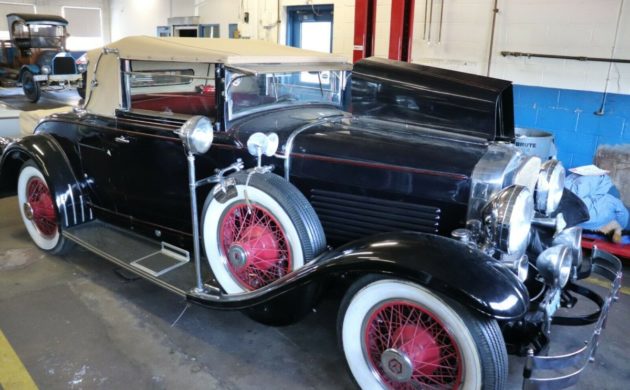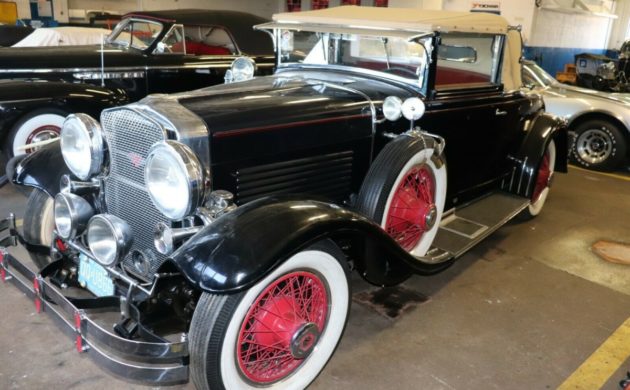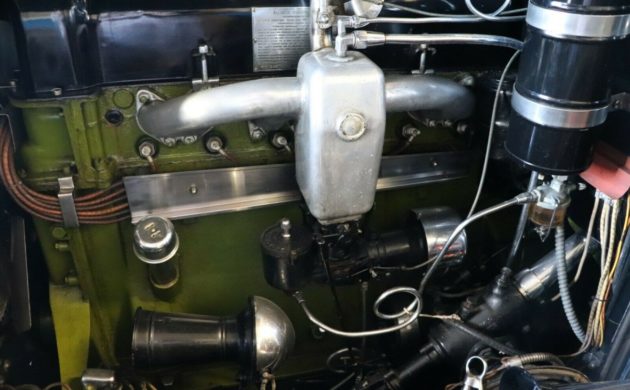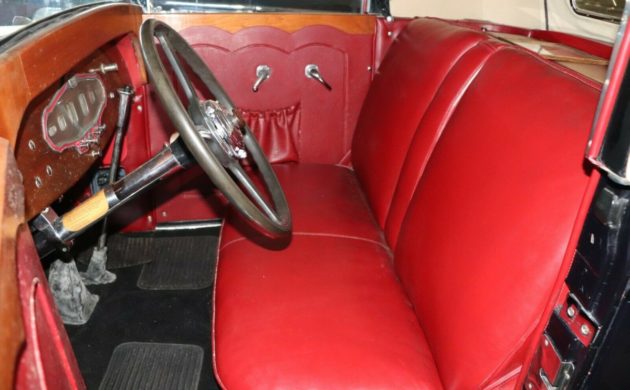 When the Stutz Motor Company was at its zenith in the 1920s, there was a story that circulated claiming that so exclusive was the ownership of a Stutz vehicle, that if an owner should happen to die in their vehicle for any reason whatsoever, they were automatically guaranteed a free obituary in the New York Times. Whether this is true or is the stuff of legend has never been clearly established. That brings us to this vehicle, the 1929 Blackhawk Cabriolet. The owner claims that this is 1-of-12 such cars that were built with a body by LeBaron. I have spent quite some time researching this claim, and while I can’t find any evidence to conclusively confirm it, I also can’t find any information that contradicts it. The Blackhawk is now looking for a new home, but it has been sitting for a number of years, and it will need to be revived. It is located in Lansdale, Pennsylvania, and has been listed for sale here on eBay. Bidding has reached $35,100, but the reserve hasn’t been met.
When the Stutz Motor Company was at its zenith in the 1920s, there was a story that circulated claiming that so exclusive was the ownership of a Stutz vehicle, that if an owner should happen to die in their vehicle for any reason whatsoever, they were automatically guaranteed a free obituary in the New York Times. Whether this is true or is the stuff of legend has never been clearly established. That brings us to this vehicle, the 1929 Blackhawk Cabriolet. The owner claims that this is 1-of-12 such cars that were built with a body by LeBaron. I have spent quite some time researching this claim, and while I can’t find any evidence to conclusively confirm it, I also can’t find any information that contradicts it. The Blackhawk is now looking for a new home, but it has been sitting for a number of years, and it will need to be revived. It is located in Lansdale, Pennsylvania, and has been listed for sale here on eBay. Bidding has reached $35,100, but the reserve hasn’t been met.  Before I delve too deeply into the specifics of this car, I probably need to clear up one misconception. While the vehicle has been listed as a Stutz, it actually isn’t. With Stutz sales following the market trends of the day for prestige makers (falling rapidly), the company decided to introduce a more affordable line of cars. In order to not sully the exclusivity of the Stutz brand, they chose the path that was followed by numerous manufacturers over the years, and established a separate marque called “Blackhawk.” That is why you can look over this entire car, and the only reference that you will find of the parent company will be on the build plate. Even the emblem on the radiator carries a unique logo, along with the Blackhawk name. This Blackhawk was restored many years ago, but it has remained in storage and unused for at least 10-years. It has only been uncovered with the owner’s recent passing, which is why it is now being offered for sale. The seller provides a decent collection of photos of the Blackhawk’s underside, and it is as clean and crisp as you might expect from a fully restored classic that has seen essentially no use. There are no signs of any rust or corrosion, with the frame looking perfect. The body itself is straight and clean, with no dings or dents. The paint is now showing some deterioration, most notably just behind the door on the passenger side. In this location, the paint has cracked quite badly, and there are some signs of flaking. Whether the next owner chooses to address these areas, or whether they treat the car to a full repaint, will be a matter of personal preference. One item that has survived exceptionally well is the Beige Cabriolet top. This looks as tight as a drum, and there are no signs of any rips, holes, or developing mildew. The exterior trim and chrome still look as good as it would have the day that the restoration was completed, but I did note one item that is missing. The radiator should have a very distinctive decorative cap on it, but this isn’t to be seen anywhere. It is to be hoped that this is somewhere in the vehicle because sourcing a replacement will almost certainly be extremely difficult.
Before I delve too deeply into the specifics of this car, I probably need to clear up one misconception. While the vehicle has been listed as a Stutz, it actually isn’t. With Stutz sales following the market trends of the day for prestige makers (falling rapidly), the company decided to introduce a more affordable line of cars. In order to not sully the exclusivity of the Stutz brand, they chose the path that was followed by numerous manufacturers over the years, and established a separate marque called “Blackhawk.” That is why you can look over this entire car, and the only reference that you will find of the parent company will be on the build plate. Even the emblem on the radiator carries a unique logo, along with the Blackhawk name. This Blackhawk was restored many years ago, but it has remained in storage and unused for at least 10-years. It has only been uncovered with the owner’s recent passing, which is why it is now being offered for sale. The seller provides a decent collection of photos of the Blackhawk’s underside, and it is as clean and crisp as you might expect from a fully restored classic that has seen essentially no use. There are no signs of any rust or corrosion, with the frame looking perfect. The body itself is straight and clean, with no dings or dents. The paint is now showing some deterioration, most notably just behind the door on the passenger side. In this location, the paint has cracked quite badly, and there are some signs of flaking. Whether the next owner chooses to address these areas, or whether they treat the car to a full repaint, will be a matter of personal preference. One item that has survived exceptionally well is the Beige Cabriolet top. This looks as tight as a drum, and there are no signs of any rips, holes, or developing mildew. The exterior trim and chrome still look as good as it would have the day that the restoration was completed, but I did note one item that is missing. The radiator should have a very distinctive decorative cap on it, but this isn’t to be seen anywhere. It is to be hoped that this is somewhere in the vehicle because sourcing a replacement will almost certainly be extremely difficult.  In order to ensure that sales of the Blackhawk did not encroach upon those of the company’s more expensive and exclusive models, the Blackhawk was offered with a 6-cylinder engine, while the rest of their offerings featured a straight-8. Developing a completely new engine was going to prove to be ruinously expensive, so in a fit of inspired thinking, they took the original eight, and effectively lopped-off cylinders 2 and 7! The result was an engine that was cheap to develop and build and utilized many of the larger engine’s components such as valves, pistons, and conrods. This new overhead cam engine had a capacity of 241ci and could pump out an extremely impressive 85hp. That was one of the great strengths of Stutz as a manufacturer. Not only were their offerings exclusive, but they also came equipped with engines that produced class-leading power outputs. Another area where the Blackhawk held an advantage over its rivals was in the area of the transmission. While the competition almost exclusively fitted their vehicles with a 3-speed manual transmission, the Blackhawk effectively led the way as one of the first American manufacturers to introduce a 4-speed manual unit. I have checked the numbers on this particular car, and while the engine is the correct type and specifications, it isn’t the original engine that was fitted to this car. The seller indicates that the engine doesn’t currently run and that all fluids were drained prior to the car being placed into storage. He doesn’t indicate whether the engine turns freely, but given the potential value of this classic, I would be checking everything very thoroughly before even considering trying to coax it back to life. Given its relative rarity, you can only begin to imagine what a rebuild would cost if it all went horribly wrong.
In order to ensure that sales of the Blackhawk did not encroach upon those of the company’s more expensive and exclusive models, the Blackhawk was offered with a 6-cylinder engine, while the rest of their offerings featured a straight-8. Developing a completely new engine was going to prove to be ruinously expensive, so in a fit of inspired thinking, they took the original eight, and effectively lopped-off cylinders 2 and 7! The result was an engine that was cheap to develop and build and utilized many of the larger engine’s components such as valves, pistons, and conrods. This new overhead cam engine had a capacity of 241ci and could pump out an extremely impressive 85hp. That was one of the great strengths of Stutz as a manufacturer. Not only were their offerings exclusive, but they also came equipped with engines that produced class-leading power outputs. Another area where the Blackhawk held an advantage over its rivals was in the area of the transmission. While the competition almost exclusively fitted their vehicles with a 3-speed manual transmission, the Blackhawk effectively led the way as one of the first American manufacturers to introduce a 4-speed manual unit. I have checked the numbers on this particular car, and while the engine is the correct type and specifications, it isn’t the original engine that was fitted to this car. The seller indicates that the engine doesn’t currently run and that all fluids were drained prior to the car being placed into storage. He doesn’t indicate whether the engine turns freely, but given the potential value of this classic, I would be checking everything very thoroughly before even considering trying to coax it back to life. Given its relative rarity, you can only begin to imagine what a rebuild would cost if it all went horribly wrong.  One area of the Blackhawk that will require little attention is the interior. This was restored at the same time as the rest of the car and has survived very nicely. As a matter of course, I would be inclined to treat the leather upholstery on the seat, door trims, and the rumble seat with a high-quality leather conditioner. Beyond that, the timber trim could be given a clean with some oil-based wood polish, and that’s about it. While the Blackhawk was intended to be a more affordable offering, the attention to detail is all that prospective owners might come to expect from Stutz. The timber trim on the tops of the doors features some scalloping, while the alloy gauge cluster is finished around the outer edge with some red enamel. You won’t find a radio, but there is a very nice clock set into the ornate gauge cluster and the handles for the shifter and park brake are beautifully cast works of art.
One area of the Blackhawk that will require little attention is the interior. This was restored at the same time as the rest of the car and has survived very nicely. As a matter of course, I would be inclined to treat the leather upholstery on the seat, door trims, and the rumble seat with a high-quality leather conditioner. Beyond that, the timber trim could be given a clean with some oil-based wood polish, and that’s about it. While the Blackhawk was intended to be a more affordable offering, the attention to detail is all that prospective owners might come to expect from Stutz. The timber trim on the tops of the doors features some scalloping, while the alloy gauge cluster is finished around the outer edge with some red enamel. You won’t find a radio, but there is a very nice clock set into the ornate gauge cluster and the handles for the shifter and park brake are beautifully cast works of art.  The Blackhawk was an experiment that Stutz undertook in a bid to regain market share, with the first cars appearing at the end of 1928. The marque soldiered on through 1929, but the experiment ended in 1930 when the Blackhawk was discontinued. However, Stutz had committed that cardinal sin of overestimating market demand, and while the Blackhawk stopped rolling off the line in 1930, the last new examples didn’t find their way to new owners until well into 1932. The 1929 model year was their most successful, with the company managing to sell 1,310 vehicles. With the advent of the 1929 stock market crash, sales inevitably fell off a cliff. The company built around 280 Blackhawks in that year, but as I said, some of those cars didn’t sell for another 2-years. It was something of a moot point really, because Stutz never recovered from the damage inflicted by the Wall Street crash, and vehicle production ended permanently in 1935. The brand was relaunched in 1970, but the reality was that the reincarnation was really Stutz in name only. It isn’t clear what the owner has set as the reserve on this Blackhawk, but I have found the same car for sale on a couple of other sites, and the price has been set at around the $90,000 mark. I guess this raises the question as to whether the Blackhawk is worth that sort of money. I did do some digging around and found a virtually identical car that sold only a few years ago. The final sale price on that example was $161,000. With that in mind, then the price that the vehicle is being advertised for is probably about right. Of course, if you can secure it for less via the eBay listing, then you could be onto a winner.
The Blackhawk was an experiment that Stutz undertook in a bid to regain market share, with the first cars appearing at the end of 1928. The marque soldiered on through 1929, but the experiment ended in 1930 when the Blackhawk was discontinued. However, Stutz had committed that cardinal sin of overestimating market demand, and while the Blackhawk stopped rolling off the line in 1930, the last new examples didn’t find their way to new owners until well into 1932. The 1929 model year was their most successful, with the company managing to sell 1,310 vehicles. With the advent of the 1929 stock market crash, sales inevitably fell off a cliff. The company built around 280 Blackhawks in that year, but as I said, some of those cars didn’t sell for another 2-years. It was something of a moot point really, because Stutz never recovered from the damage inflicted by the Wall Street crash, and vehicle production ended permanently in 1935. The brand was relaunched in 1970, but the reality was that the reincarnation was really Stutz in name only. It isn’t clear what the owner has set as the reserve on this Blackhawk, but I have found the same car for sale on a couple of other sites, and the price has been set at around the $90,000 mark. I guess this raises the question as to whether the Blackhawk is worth that sort of money. I did do some digging around and found a virtually identical car that sold only a few years ago. The final sale price on that example was $161,000. With that in mind, then the price that the vehicle is being advertised for is probably about right. Of course, if you can secure it for less via the eBay listing, then you could be onto a winner.
• For Sale • 10 Comments
1-of-12: 1929 Stutz Blackhawk Cabriolet
Disclosure: This site may receive compensation from some link clicks and purchases.


I took my drivers test in just like this but blue.
Really Weasel? – just like the Heuer Camaro watch…? Pretty impressive driver’s test.
Now this is a true classic. If you have the cash to spare it’s probably a great investment. Speculation is a difficult option in these trying times, but that’s how millionaires are made, or broke.
God bless America
More in my price and preference range is the ’41 Buick cvt in Ebay pictures #6 and #13
Price is not right. Not running, probably 1/2 that. Don’t compare it to the Eight cylinder cars.
Looks like this poor car is the victim of yet another market crash. It’s bad enough trying to sell a classic car at this time,
but a blue chip car like this one? Forget it. With the economy
in the toilet, the seller won’t get the price he’s asking. After viewing the markets Friday, it would be a good idea to hunker
down and wait this one out before spending money that you
may not have. One thing’s for sure, the car looks great and is a
real treat to behold. Last one I saw was 50+ years ago in an article in Car Classics Magazine that profiled the Stutz Motor
Car Company. The car I saw in the article was finished in a 2
tone grey paint scheme with black wire rims and a gorgeous
grey leather interior with charcoal colored carpets. Didn’t think
I’d ever see one again in my lifetime until now. Happy Easter to
all and stay safe.
So following car sold for around 50k from a well known dealer about 6 or 7 years ago. That market was better than today. It was an eight cylinder car (Model M), longer wheelbase, it ran but the motor knocked.
It s now for sale in Europe for twice that, I assume they fixed the knock cause it doesn’t look any different than before.
https://classics.autotrader.com/classic-cars/1929/stutz/model_m/100878881
Love the drag link held on with bailing wire and the boogie exhaust system.
Make that bodgie exhaust system.
The dealer selling this Stutz (Old Forge Motorcars Inc.) is asking $89,900 for it on its website, so it looks like the eBay listing has a way to go.